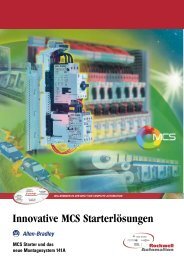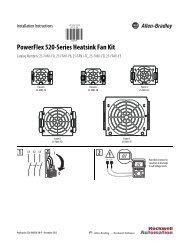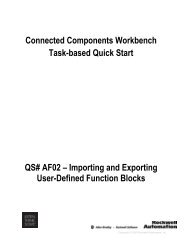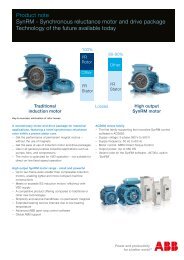Temperature Controller - Staveb AG
Temperature Controller - Staveb AG
Temperature Controller - Staveb AG
- No tags were found...
You also want an ePaper? Increase the reach of your titles
YUMPU automatically turns print PDFs into web optimized ePapers that Google loves.
Parameter Functions and Definitions 5-23Standard/Heating and CoolingConditions of Use: The ordered Bulletin 900-TC32 must support theAlarm 1 Output (see Table 1.A).Function: This parameter allows you to configure the controller for standardcontrol mode or heating and cooling control.When heating and cooling control is selected, the Alarm 1 Output terminalALM1 is used for cooling side control output. So, alarm 1 cannot be used.Table 5.YSelectionsstnd: Standardh-c: Heating and coolingDefault SelectionstndRelated Parameters• MV Monitor (OUT1) (p. 5-8), MV Monitor (OUT2) (p. 5-8) (Operationfunction group)• Alarm Value 1 (p. 5-6), Upper-Limit Alarm Value 1, Lower-Limit AlarmValue 1 (p. 5-7) (Operation function group)• Hysteresis (OUT2) (p. 5-17), Cooling Coefficient (p. 5-15), Dead Band(p. 5-16) (Adjustment function group)• Control Period (OUT2) (Initial Setting function group) (p. 5-24)• Alarm 1 Type (Initial Setting function group) (p. 5-26)• Alarm 1 Hysteresis (p. 5-33), Alarm 1 Open in Alarm (p. 5-32)(Advanced Setting function group)ST Self-TuningConditions of Use: The input type must be set to temperature input, with thestandard control mode, and 2-PID control method enabled.Function: This parameter allows you to configure the controller to executethe self-tuning function. The ST (self-tuning) function executes tuning fromthe start of program execution to calculate the PID constants matched to thecontrol target of the application. When the ST function is in operation, makesure to turn the power supply of the load connected to the control out put ONsimultaneously with or before starting operation of the Bulletin 900-TC32.Publication 900-UM003C-EN-E - January 2004
















